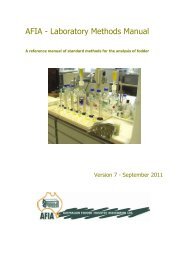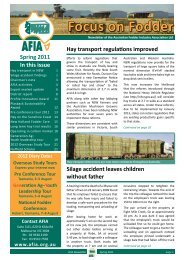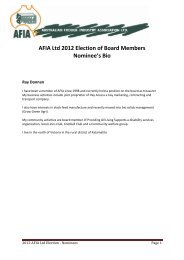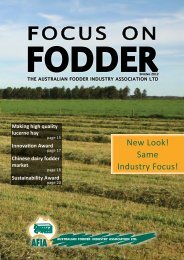Focus on Fodder - Australian Fodder Industry Association
Focus on Fodder - Australian Fodder Industry Association
Focus on Fodder - Australian Fodder Industry Association
You also want an ePaper? Increase the reach of your titles
YUMPU automatically turns print PDFs into web optimized ePapers that Google loves.
...compost for the 21st century<br />
C<strong>on</strong>tinued from page 1<br />
For a soil to be healthy, we know we<br />
need the comp<strong>on</strong>ent parts to be<br />
healthy—its chemical, biological and<br />
physical properties. These properties<br />
determine how well the soil functi<strong>on</strong>s<br />
– how it drains, holds water, holds<br />
nutrients, and how well it grows<br />
pasture or crops.<br />
As the diagram (below) shows how<br />
organic matter (OM) is central to the<br />
soils c<strong>on</strong>diti<strong>on</strong>. It performs critical<br />
roles in the biological, physical and<br />
chemical functi<strong>on</strong>ing of soil and helps<br />
to maintain c<strong>on</strong>diti<strong>on</strong>s c<strong>on</strong>ducive for<br />
plant growth. OM:<br />
is the food that sustains soil<br />
organisms;<br />
c<strong>on</strong>tains most of the nutrients in the<br />
soil that sustain plants;<br />
holds nutrients in such a way that<br />
plants can access them;<br />
forms bridges with the clay<br />
comp<strong>on</strong>ent of soil to provide<br />
structure; and<br />
holds water and makes it available<br />
to plants.<br />
Physical functi<strong>on</strong>s<br />
• influences soil structure, stability<br />
• regulates water holding capacity<br />
• c<strong>on</strong>trols gaseous exchange<br />
• alters soil thermal properties<br />
page 16<br />
Biological functi<strong>on</strong>s<br />
• drive nutrient cycling processes<br />
• drives carb<strong>on</strong> cycling<br />
• source of energy<br />
• reservoir of nutrients<br />
organic matter<br />
In fact, OM is so important our soils<br />
would be dead without it.<br />
There is growing awareness in<br />
agriculture that we need to manage<br />
OM better than we have in the past.<br />
Research has shown that OM levels<br />
decline sharply following land clearing.<br />
In fact, every time we cultivate land<br />
we stimulate the degradati<strong>on</strong> of OM.<br />
The good news is that this is usually a<br />
slow process; the bad news is that it<br />
is equally slow if you want to re-build<br />
levels of OM in your soils.<br />
Building OM involves a range of<br />
strategies. You can grow it (perennial<br />
pastures), spread it (animal<br />
manures), or make it (composts). All<br />
strategies have their place and all<br />
have advantages and disadvantages.<br />
Growing it is great but is slow, so l<strong>on</strong>g<br />
as you d<strong>on</strong>’t cultivate that paddock. If<br />
you do OM is likely to decline faster<br />
than it accumulated. Spreading it is<br />
great too, and quicker than growing it,<br />
but you have to have access to good<br />
quantities of manure to make it work.<br />
Chemical functi<strong>on</strong>s<br />
• cati<strong>on</strong> exchange capacity<br />
• buffers changes in pH<br />
• storage/cycling of nutrients<br />
• complexes with soil organic C<br />
AFIA Newsletter Winter 2012<br />
On Farm<br />
Making compost with low quality hay.<br />
Composting is also an excellent way<br />
to increase OM. Advantages include<br />
its soil improvement properties,<br />
nutrient status and affordability, if<br />
you have access to the raw materials.<br />
Disadvantages generally surround<br />
making and handling compost.<br />
However, a growing number of farmers<br />
are exploring the opti<strong>on</strong>s of making<br />
or buying in compost, and using it<br />
in c<strong>on</strong>juncti<strong>on</strong> with their inorganic<br />
fertilisers to boost soil health and<br />
maintain productivity.<br />
Trying to make compost <strong>on</strong> farm is a big<br />
hassle <strong>on</strong>ly if you are not properly set<br />
up, and if you d<strong>on</strong>’t do it properly. But<br />
farmers who have invested the time<br />
and effort to get set up are reaping the<br />
benefits, with most reporting some<br />
improvement in their farming system.<br />
Improvements include soil c<strong>on</strong>diti<strong>on</strong>,<br />
animal health, product quality and<br />
profit. Well set-up farmers report costs<br />
in the order of $100–250 to make and<br />
spread 3 t/ha compost.<br />
Probably the most important thing<br />
for commercial scale composting is<br />
owning, or having access to, a compost<br />
turner. This single factor is largely<br />
resp<strong>on</strong>sible for the growth in compost<br />
use in places like the South West,<br />
Gippsland and North Central areas of<br />
Victoria, where c<strong>on</strong>tractors are making<br />
turning services available <strong>on</strong>-farm.<br />
You can make compost quite well<br />
with a fr<strong>on</strong>t-end loader–in fact it is<br />
recommended that you start that way<br />
<strong>on</strong> a small scale while you develop a<br />
‘brown’ thumb. Select a small area–<br />
say 1-5 hectares of average land, not







